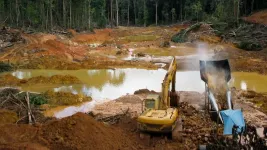(Press-News.org) xIt would be greatly beneficial to physicians trying to save lives in intensive care units if they could be alerted when a patient’s condition rapidly deteriorates or shows vitals in highly abnormal ranges.
While current machine learning models are attempting to achieve that goal, a Virginia Tech study recently published in Communications Medicine shows that they are falling short with models for in-hospital mortality prediction, which refers to predicting the likelihood of a patient dying in the hospital, failing to recognize 66 percent of the injuries.
“Predictions are only valuable if they can accurately recognize critical patient conditions. They need to be able to identify patients with worsening health conditions and alert doctors promptly,” said Danfeng “Daphne” Yao, professor in the Department of Computer Science and affiliate faculty at the Sanghani Center for Artificial Intelligence and Data Analytics.
“Our study found serious deficiencies in the responsiveness of current machine learning models,” said Yao. “Most of the models we evaluated cannot recognize critical health events and that poses a major problem.”
To conduct their research, Yao and computer science Ph.D. student Tanmoy Sarkar Pias collaborated with:
Sharmin Afrose, Oak Ridge National Laboratory, Tennessee
Moon Das Tuli, Greenlife Medical College Hospital, Dhaka, Bangladesh
Ipsita Hamid Trisha, Banner University Medical Center, Tucson, and University of Arizona College of Medicine
Xinwei Deng, Department of Statistics at Virginia Tech
Charles B. Nemeroff, Department of Psychiatry and Behavioral Sciences, University of Texas at Austin Dell Medical School
Their paper, “Low Responsiveness of Machine Learning Models to Critical or Deteriorating Health Conditions,” shows patient data is not enough to teach models how to determine future health risks. Calibrating health care models with “test patients” helps reveal the models’ true ability and limitations.
The team developed multiple medical testing approaches, including a gradient ascent method and neural activation map. Color changes in the neural activation map indicate how well machine learning models react to worsening patient conditions. The gradient ascent method can automatically generate special test cases, making it easier to evaluate the quality of a model.
“We systematically assessed machine learning models’ ability to respond to serious medical conditions using new test cases, some of which are time series, meaning they use a sequence of observations collected at regular intervals to forecast future values,” Pias said. “Guided by medical doctors, our evaluation involved multiple machine learning models, optimization techniques, and four data sets for two clinical prediction tasks.”
In addition to models failing to recognize 66 percent of injuries for in-hospital mortality prediction, the models failed to generate, in some instances, adequate mortality risk scores for all test cases. The study identified similar deficiencies in the responsiveness of five-year breast and lung cancer prognosis models.
These findings inform future health care research using machine learning and artificial intelligence (AI), Yao said, because they show that statistical machine learning models trained solely from patient data are grossly insufficient and have many dangerous blind spots. To diversify training data, one may leverage strategically developed synthetic samples, an approach Yao’s team explored in 2022 to enhance prediction fairness for minority patients.
“A more fundamental design is to incorporate medical knowledge deeply into clinical machine learning models,” she said. “This is highly interdisciplinary work, requiring a large team with both computing and medical expertise."
In the meantime, Yao’s group is actively testing other medical models, including large language models, for their safety and efficacy in time-sensitive clinical tasks, such as sepsis detection.
"AI safety testing is a race against time, as companies are pouring products into the medical space," she said. “Transparent and objective testing is a must. AI testing helps protect people’s lives and that’s what my group is committed to.”
END
Machine learning models fail to detect key health deteriorations, Virginia Tech research shows
The study published in Communications Medicine reveals that 66 percent of critical injuries in hospitals would go unnoticed if the current models were put to use.
2025-03-11
ELSE PRESS RELEASES FROM THIS DATE:
Women with PVD often underdiagnosed & undertreated, highlighting need for more research
2025-03-11
Statement Highlights:
Peripheral vascular disease (PVD)—a condition affecting arteries, veins and the lymphatic systems throughout the body—has significant differences in incidence, risk factors, diagnosis, treatment and outcomes in women vs. men.
Women with PVD often experience subtle or atypical symptoms, which can lead to underdiagnosis or delay in diagnosis, and they are less likely to receive guideline-recommended treatments.
Targeted screening, tailored treatment strategies and increased representation of women in clinical trials are critical priorities to addressing these gaps ...
New Irresistible Materials CEO to drive commercialization and market adoption
2025-03-11
University of Birmingham spin-out Irresistible Materials Ltd (IM), a leader in the development of novel resist materials for extreme ultraviolet (EUV) lithography, has announced the appointment of Dinesh R. Bettadapur as its new chief executive officer (CEO) and board director.
Bettadapur brings a wealth of business experience and strategic vision to the company, having previously held leadership roles at ASML, Intel, and Lam Research, as well as multiple Silicon Valley startups where he enabled significant business growth leading to three successful exits.
In his new role, Bettadapur will lead IM’s business strategy and commercial engagements ...
Gold mining in the Peruvian Amazon has done more damage to peatlands in the last two years than in the previous three decades
2025-03-11
New research published in the academic journal Environmental Research Letters reveals that artisan gold mining in the southern Peruvian Amazon has caused more destruction to carbon-rich peatlands in the past two years than in the previous three decades combined, posing a serious threat to the environment and climate.
For decades, small-scale gold mining has thrived along the rivers of the Madre de Dios region, driven by gold frequently found in the surrounding soils. While the deforestation caused by mining has already resulted in significant carbon emissions, scientists have now discovered that the damage ...
Cheap and environmentally friendly – the next generation LEDs may soon be here
2025-03-11
Cost, technical performance and environmental impact – these are the three most important aspects for a new type of LED technology to have a broad commercial impact on society. This has been demonstrated by researchers at Linköping University in a study published in Nature Sustainability.
“Perovskite LEDs are cheaper and easier to manufacture than traditional LEDs, and they can also produce vibrant and intense colours if used in screens. I’d say that this is the next generation ...
Rare frog rediscovered after 130 years
2025-03-11
A team of researchers has rediscovered a frog species which has not been seen in more than 130 years. First described in 1902, Alsodes vittatus had evaded detection since then, despite multiple search efforts. The researchers discovered two populations of the frog at the southeastern end of the ancient Hacienda San Ignacio de Pemehue in La Araucanía Region, Chile. The rediscovery is an important milestone for South American herpetology and the conservation of biodiversity in the southern cone.
The frog Alsodes vittatus is an elusive creature – described in 1902, it managed to go undetected for more than a century. Now, after a decade of investigation, a research team ...
Earth's 'dirty mirror' effect is accelerating climate change
2025-03-11
Earth is absorbing more sunlight and trapping more heat than it releases into space, causing our planet to warm up at an increasing rate.
New research shows that cloudy areas over oceans are reflecting less sunlight to space than before, adding to heating from rising greenhouse gas levels and causing climate change to accelerate.
The study, published today (Tuesday, 11 March) in Environmental Research Letters, found this dimming effect was occurring in several regions, including cloudy areas off the coasts of California and Namibia, ...
Breakthrough in next-generation polio vaccines
2025-03-11
A more affordable, lower-risk polio vaccine is on the horizon, research led by the University of Leeds has found.
Researchers have taken a major step towards producing a more affordable and lower-risk polio vaccine using virus-like particles (VLPs). These particles mimic the outer protein shell of poliovirus, but are empty inside. This means there is no risk of infection, but the VLP still causes the immune system to respond.
Now, a research project led by Professor David Rowlands, Emeritus Professor of Molecular Virology at the University of Leeds, has tested the effectiveness of using different yeast, insect, mammalian and ...
A call for federally funded pediatric firearm injury prevention research
2025-03-11
BOSTON, MASSACHUSETTS – Firearm-related injuries are the leading cause of death among children and adolescents in the United States, yet research on firearm injury prevention receives significantly less federal funding compared to other major pediatric health concerns. A new paper published in Pediatrics underscores the critical need for an enhanced federal investment in firearm injury prevention research to address the rising rates of fatalities and injuries.
“Expanding the field of firearm injury ...
New research reveals how a 252 million year old climate crisis accompanied the ‘Great Dying’ mass extinction event, completely reorganizing the Earth’s ecosystems
2025-03-11
The mass extinction that ended the Permian geological epoch, 252 million years ago, wiped out most animals living on Earth. Huge volcanoes erupted, releasing 100,000 billion metric tons of carbon dioxide into the atmosphere. This destabilized the climate and the carbon cycle, leading to dramatic global warming, deoxygenated oceans, and mass extinction. However, many plants survived, leaving behind fossils which scientists have used to model a dramatic 10 degree rise in global temperatures.
“While fossilized spores and pollen of plants from the Early Triassic do not provide strong evidence for a sudden and catastrophic ...
Untangling quantum entanglement with new calculation formulas
2025-03-11
Once described by Einstein as “spooky action at a distance,” quantum entanglement may now seem less intimidating in light of new research findings.
Osaka Metropolitan University physicists have developed new, simpler formulas to quantify quantum entanglement in strongly correlated electron systems and applied them to study several nanoscale materials. Their results offer fresh perspectives into quantum behaviors in materials with different physical characteristics, contributing to advances in quantum technologies.
Quantum entanglement is a unique phenomenon ...
LAST 30 PRESS RELEASES:
NASA’s Webb telescope finds bizarre atmosphere on a lemon-shaped exoplanet
The gut bacteria that put the brakes on weight gain in mice
Exploring how patients feel about AI transcription
Category ‘6’ tropical cyclone hot spots are growing
Video: Drivers struggle to multitask when using dashboard touch screens, study finds
SLU research shows surge in alcohol-related liver disease driving ‘deaths of despair’
Rising heat reshapes how microbes break down microplastics, new review finds
Roots reveal a hidden carbon pathway in maize plants
Membrane magic: FAMU-FSU researchers repurpose fuel cells membranes for new applications
UN Member States pledge to increase access to diagnosis and inhaled medicines for the 480 million people living with COPD
Combination therapy shows potential to treat pediatric brain cancer ATRT
Study links seabird nesting to shark turf wars in Hawai‘i
Legal sports betting linked to sharp increases in violent crime, study finds
Breakthrough AI from NYUAD speeds up discovery of life-supporting microbes
New Eva Mayr-Stihl Foundation funding initiative boosts research at University of Freiburg on adaptation of forests to global change
The perfect plastic? Plant-based, fully saltwater degradable, zero microplastics
Bias in data may be blocking AI’s potential to combat antibiotic resistance
Article-level metrics would provide more recognition to most researchers than journal-level metrics
Satiety’s little helper: Protein that supports appetite regulating protein identified
UF dives deep into predicting storm damage with computer models
A stormy ocean voyage yields insights on the global carbon cycle
Scientists identify first non-coding gene that controls cell size
Demonstration of altermagnetism in RuO₂ thin films -- A new magnetic material for the AI era
Penn researchers awarded $25M to conduct trial using smartphones to fight heart disease
PCORI awards funding for new patient-centered healthcare research
Exploring the origins of the universe: 145 low-noise amplifiers complete ALMA telescopes
Empress cicada wings help illuminate molecular structure
Using sound waves to detect helium
Time burden in patients with metastatic breast and ovarian cancer from clinic and home demands
Researchers discover bias in AI models that analyze pathology samples
[Press-News.org] Machine learning models fail to detect key health deteriorations, Virginia Tech research showsThe study published in Communications Medicine reveals that 66 percent of critical injuries in hospitals would go unnoticed if the current models were put to use.






